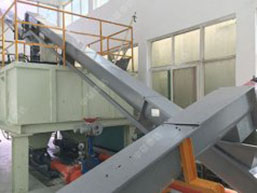As an indispensable process in clothing industry, textile dying industry is both loved and hatred by people. What people love is that through the development of the printing and dyeing industry, life becomes more beautiful and clothes more colorful. What people hate is that printing and dyeing industry is a well-known major pollution source. The printing and dyeing wastewater has the characteristics of large changes in water quality, high concentration of organic pollutants, large changes in chroma and PH value and etc. Printing and dyeing sludge contains dyes, slurries and additives. Composition of printing and dying sludge is very complex. Structure of dye contains nitro, amino compounds and heavy metal elements such as copper, chromium, zinc and arsenic. Dye holds relatively large biological toxicity and strong pollution to the environment. Dye is regarded as hazardous waste. Currently, printing and dyeing sludge is uniformly collected by qualified sludge recycling agency for recycling which will cost certain expense. Therefore, for many printing and dyeing enterprises, it is also a large cost. With continuous growth of urban population and rapid development of industrial production, volume of urban domestic sewage and industrial waste water keep increasing day by day. Printing and dyeing waste water occupies a large proportion in our country's industrial waste water and mainly exists in coastal regions including Guangdong, Zhejiang, Jiangsu, Fujian and Shandong. Composition of printing and dyeing waste water is complex and it mainly contains a large amount of dyes, slurry material, surfactants and alkalis. At the same time, owing to large chroma, strong alkalinity and high organic content, printing and dyeing sludge is one of industrial waste water relatively difficult to treat.
Printing and dyeing sludge is residue produced during waste water treatment process of printing and dyeing enterprises. It contains a certain amount of pollutants mainly including bacterial microorganisms, organic debris, inorganic substances and colloids. It is an extremely complex heterogeneous body with high organic content and high heat. With vigorous development of printing and dyeing industry, disposal regulations in our country becomes stricter and stricter. After waste water treatment plant matched for printing and dyeing enterprise put into operation, a large amount of sludge is produced every day correspondingly. What’s more, after disposal of printing and dyeing waste water tends to be centralized, amount of sludge increases day by day and composition of sludge produced is becoming more and more complex. Common treatment method for sludge produced in large amount is to use a mechanical filter press to reduce moisture content of sludge below 80%. Then, transport the sludge out and do final disposal by landfill, stacking, or dumping way. Such disposal methods often cause secondary pollution to natural environment and bring about severe environmental safety hazards.
Mature treatment method of printing and dyeing sludge is to reduce its volume by drying and do resource disposal. Common resource utilization method is ①use dried sludge as fuel for incineration to replace coal consumption and reduce enterprises’ production cost; ②mixing into shale material and make sintered bricks; ③Use sludge to produce high-temperature calcined ceramsite. Based on above resource utilization methods, TAEDA can design drying plan and can also provide complete deep processing technology and equipment manufacturing support services.
In terms of sludge drying and amount reduction , TAEDA recommends you the following drying technologies and equipment that have been optimized for many years and are highly praised: low temperature belt drying system, exhaust heat low temperature drum drying system, steam rotary drum drying system, rotary drum sludge drying system and air swept rotary wing drying system. You can either click on following "Recommended Process" below for details or call us directly for quotation and technical support.
* Three-new advantage: form long-term cooperative relations with universities and scientific research institutions to provide new technologies, new ideas and new directions.
* Three-speciality advantage: Professional manufacturing and R&D on drying equipment, combination with professional testing institutions and cooperation with professional research and design institutes. We can provide full-process services from project planning, blueprint design to finished product testing, environmental assessment and laboratory construction.
* Three-deep advantage: Production line holds wide application range and can cover each circle. Process details and equipment design are deeply optimized based on multiple working cases, different projects and years’ R&D.
* Three-large advantage: Taeda holds large standard mechanical manufacture base and establishes cooperation with universities and professional institutes. Taeda also have multiple large automatic manufacture processing lines.
-
 Low-temp Belt Drying System
Low-temp Belt Drying System
-
 Exhaust Heat Drum Drying
Exhaust Heat Drum Drying
-
 Steam Rotary Drying System
Steam Rotary Drying System
-
 Rotary Drum Drying System
Rotary Drum Drying System
-
 Air Swept Drying System
Air Swept Drying System
| Model | Working principle | Working temperature | Heat source | Occupation area | Brand | Capacity |
| ℃ | t/h |
| MED | Hot air rotary drum dryer | 200-750 | electricity, gas, oil, coal and biomass pellets | Middle | Taeda | 0.5-50 |
| WWD | Circulation hot air mesh belt dryer | 60-300 | electricity, gas, heat conduction oil, hot water,exhaust gas, heat | Large | Zonelion | 0.05-5 |
| OSC | Airflow fluid bed dryer | 120-750 | electricity, gas, oil, coal and biomass pellets | Very small | 中联泰达 | 0.1-10 |
| GD | Steam tube rotar drum dryer | 100-170 | steam, heat conduction oil, hot water | Relatively large | Taeda | 0.1-8 |
| WRC | Low temperature large air volume rotary drum dryer | 45-750 | flue gas, exhaust gas, steam heat exchanging | Relatively large | Zonelion | 0.1-20
|
 中文
中文 English
English Home
Home













